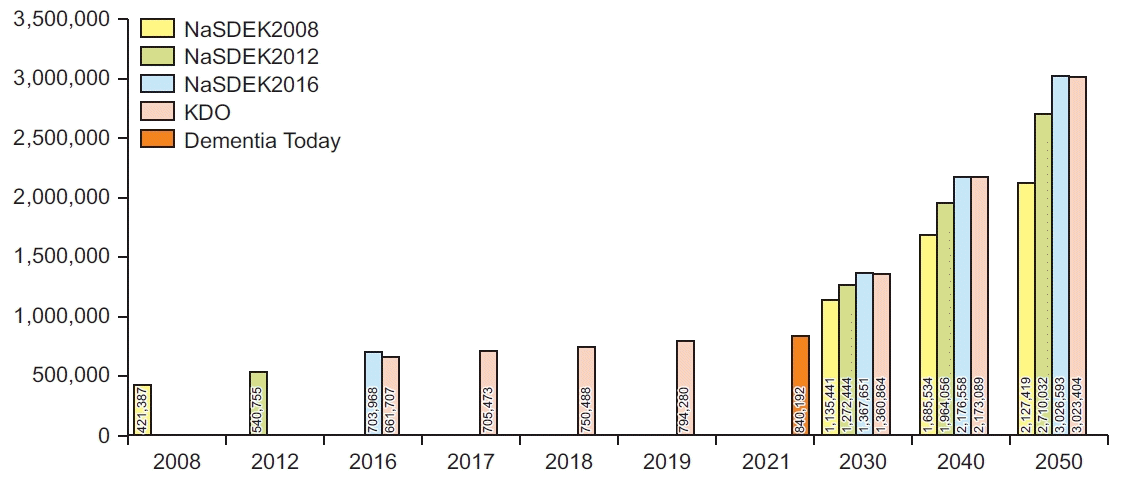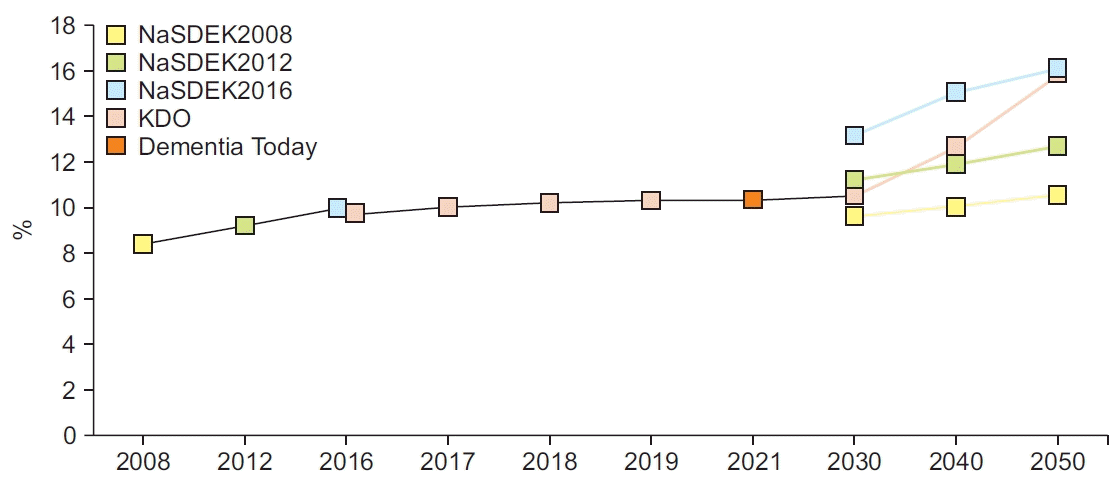1. Am Psychiatric Association. Diagnostic and statistical manual of mental disorders, fifth edition (DSM-5). Washington, DC: Am Psychiatric Association;2013.
4. Shon C, Yoon H. Health-economic burden of dementia in South Korea. BMC Geriatr. 2021; 21:549.

5. Kim YJ, Han JW, So YS, Seo JY, Kim KY, Kim KW. Prevalence and trends of dementia in Korea: a systematic review and meta-analysis. J Korean Med Sci. 2014; 29:903–12.

7. Kim KW, Suh SW, Kim YJ. An 8‐year comparison of dementia prevalence in Korea: results from the nationwide survey on dementia epidemiology of Korea, 2008 and 2016: epidemiology/prevalence, incidence, and outcomes of MCI and dementia. Alzheimers Dement. 2020; 16:e041839.
8. Kim KW, Park JH, Kim MH, Kim MD, Kim BJ, Kim SK, et al. A nationwide survey on the prevalence of dementia and mild cognitive impairment in South Korea. J Alzheimers Dis. 2011; 23:281–91.

9. Ministry of Health and Welfare. 2012 nationwide survey on the dementia epidemiology of Korea. Seoul, Kore: Ministry of Health and Welfare;2012. p. 83–151.
11. Han JW, Kim TH, Jhoo JH, Park JH, Kim JL, Ryu SH, et al. A normative study of the Mini-Mental State Examination for Dementia Screening (MMSE-DS) and its short form(SMMSE-DS) in the Korean elderly. J Korean Geriatr Psychiatry. 2010; 14:27–37.
12. Lee JH, Lee KU, Lee DY, Kim KW, Jhoo JH, Kim JH, et al. Development of the Korean version of the Consortium to Establish a Registry for Alzheimer’s Disease Assessment Packet (CERAD-K): clinical and neuropsychological assessment batteries. J Gerontol B Psychol Sci Soc Sci. 2002; 57:P47–53.

13. Morris JC. The clinical dementia rating (CDR): current version and. Young. 1991; 41:1588–92.
14. American Psychiatric Association. Diagnostic and statistical manual of mental disorders, third edition (DSM-III). Washington, DC: American Psychiatric Association;1980.
15. McKhann G, Drachman D, Folstein M, Katzman R, Price D, Stadlan EM. Clinical diagnosis of Alzheimer’s disease: report of the NINCDS-ADRDA Work Group under the auspices of Department of Health and Human Services Task Force on Alzheimer’s Disease. Neurology. 1984; 34:939–44.

16. Roman GC, Tatemichi TK, Erkinjuntti T, Cummings JL, Masdeu JC, Garcia JH, et al. Vascular dementia: diagnostic criteria for research studies: report of the NINDS-AIREN International Workshop. Neurology. 1993; 43:250–60.

17. Winblad B, Palmer K, Kivipelto M, Jelic V, Fratiglioni L, Wahlund LO, et al. Mild cognitive impairment : beyond controversies, towards a consensus: report of the International Working Group on Mild Cognitive Impairment. J Intern Med. 2004; 256:240–6.

18. Ohara T, Hata J, Yoshida D, Mukai N, Nagata M, Iwaki T, et al. Trends in dementia prevalence, incidence, and survival rate in a Japanese community. Neurology. 2017; 88:1925–32.

19. National Institute of Dementia. Korea Dementia Observatory 2020. Seoul, Korea: National Institute of Dementia;2021.
20. National Institute of Dementia. Korea Dementia Observatory 2017. Seoul, Korea: National Institute of Dementia;2017.
21. National Institute of Dementia. Korea Dementia Observatory 2018. Seoul, Korea: National Institute of Dementia;2018.
22. National Institute of Dementia. Korea Dementia Observatory 2019. Seoul, Korea: National Institute of Dementia;2020.
23. Seong SC, Kim YY, Khang YH, Park JH, Kang HJ, Lee H, et al. Data Resource Profile: The National Health Information Database of the National Health Insurance Service in South Korea. Int J Epidemiol. 2017; 46:799–800.
24. Health Insurance Review and Assessment Service. Analysis of medical use of dementia patients. Wonju, Korea: Health Insurance Review and Assessment Service;2018.
25. National Evidence-based Healthcare Collaborating Agency. Development of a methodology for estimating financial needs related to dementia. Seoul, Korea: National Evidence-based Healthcare Collaborating Agency;2017.
26. Bae JB, Kim YJ, Han JW, Kim TH, Park JH, Lee SB, et al. Incidence of and risk factors for Alzheimer’s disease and mild cognitive impairment in Korean elderly. Dement Geriatr Cogn Disord. 2015; 39:105–15.

27. Jang JW, Park JH, Kim S, Lee SH, Lee SH, Kim YJ. Prevalence and incidence of dementia in South Korea: a nationwide analysis of the National Health Insurance Service Senior Cohort. J Clin Neurol. 2021; 17:249–56.

28. Kim YI, Kim YY, Yoon JL, Won CW, Ha S, Cho KD, et al. Cohort Profile: National health insurance servicesenior (NHIS-senior) cohort in Korea. BMJ Open. 2019; 9:e024344.

29. Wu YT, Beiser AS, Breteler MM, Fratiglioni L, Helmer C, Hendrie HC, et al. The changing prevalence and incidence of dementia over time - current evidence. Nat Rev Neurol. 2017; 13:327–39.





 PDF
PDF Citation
Citation Print
Print





 XML Download
XML Download